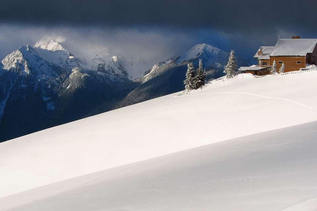This urban loop begins at the Fort Vancouver National Historic Site Visitor Center. If the Visitor Center is not open, parking is available in several lots along Officers Row on East Evergreen Blvd.
Walk down the paved roadway through the Fort Vancouver grounds to the reconstructed Fort Vancouver and the authentic 1845 garden on East 5th Street. (There is an $10 per person entrance fee to tour the reconstructed stockade and its ten buildings that tell the history of fur trade center of the West Coast.)
Turn right on East 5th Street and walk to the start of the Land Bridge Trail, which is marked by a sign. The asphalt trail is open to pedestrians and bicyclists. It goes through the historic Fort Vancouver orchard and passes Kanaka Village where the workforce employed at Fort Vancouver lived. Two houses have been reconstructed and nearby exhibit panels help to interpret these buildings.
The Land Bridge, designed by renowned architect Maya Lin, connects Fort Vancouver to the Columbia River waterfront over State Highway 14. It was dedicated in 2008 as part of the Confluence Project commemorating the 200th anniversary of the Lewis and Clark Expedition. Panels along the Land Bridge trace area history from pre-European times to the Kaiser Shipyards of World War II. Two gazebo overlooks offer interpretive signs and views to the Columbia River and Mount Hood on the horizon.
The Land Bridge Trail ends at the Old Apple Tree Park. This tree, planted in 1826, was the first apple tree in the Pacific Northwest and is considered the matriarch of Washington’s apple industry. The Old Apple Tree died in 2020 but its heritage lives on through a sapling that sprouted from its roots and share its genetic makeup.
Walk through a tunnel under the railroad berm to reach Columbia Way. Fort Vancouver Waterfront Park is across the street with park benches and viewing platforms that provide excellent views of the Columbia River and the Oregon shore. This was the location of the historic Fort Vancouver wharf in the early nineteenth century. Later, the U.S. Army used the site for its wharf.
Cross Columbia Way, turn right and walk under the I-5 bridge. The Captain George Vancouver Monument Plaza lies just west of the I-5 bridge. The plaza features Jay Rood's 1992 sculpture “Boat of Discovery” and interpretive panels about the European “discovery” of the northwest coast of North America.
Walk north on Columbia Street to Esther Short Park. This 5-acre park is the oldest public square in the Pacific Northwest, dedicated in 1855. Features include an iconic bell tower and a water feature.
At the north end of the park, turn right on West 8th Street and walk two blocks east to Main Street. Turn left and walk north two blocks to Evergreen Blvd. Turn right on East Evergreen. In two blocks, reach the Vancouver Community Library on the corner of C Street.
The Providence Academy is located across East Evergreen from the library. This brick building was built in 1873 by pioneer nun Mother Joseph as a school, orphanage and governance offices for all Sisters of Providence ministries in the Pacific Northwest. Mother Joseph designed the building and supervised its construction, even teaching a local man to make the one million bricks needed for the project. Mother Joseph went on to develop 29 more schools and hospitals in the Pacific Northwest, forming the original core of not-for-profit Providence Health & Services.
Continue walking east on East Evergreen, crossing over I-5 on an overpass and entering Officers Row. Situated adjacent to Fort Vancouver, Officers Row consists of beautifully restored nineteenth century homes which housed U.S. Army officers stationed at the Vancouver Barracks.
At the corner with Fort Vancouver Way, the rear of the O.O. Howard House is on the right. This Italianate-style house was built in 1878 and named for its first inhabitant. Recipient of the Congressional Medal of Honor in the Civil War, Howard was the first head of the Freedman's Bureau, established in 1865 to aid former slaves. Howard University in Washington, D.C. was named in recognition of his work.
Cross Fort Vancouver Way and East Evergreen to walk along the houses on Officers Row. The Ulysses S. Grant House is the oldest on Officers Row, built in 1850 as a log structure and later covered with plank siding. Although President Grant never lived in the Grant House, he served as quartermaster at Fort Vancouver from 1852 to 1853 and was the leading general in the Union Army.
The General George C. Marshall House was built in 1886 as a Queen Anne Victorian. Marshall lived in the residence from 1936 to 1938 while he commanded the Third Division’s fifth Infantry Brigade and the region’s Civilian Conservation Corps camps. He later became U.S. Army Chief of Staff during World War II, Secretary of State and Secretary of Defense, and earned a Nobel Peace Prize in 1953 for his work on the Marshall Plan.
Continue to the Fort Vancouver Visitor Center or your parking space on Officers Row to complete the loop.






 Trailhead
Trailhead



